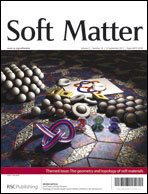Wrinkle to fold transition: influence of the substrate response
Abstract
Spatially confined rigid membranes reorganize their morphology in response to imposed constraints. Slight compression of a rigid membrane resting on a soft foundation creates a regular pattern of sinusoidal wrinkles with a broad spatial distribution of energy. For larger compression, the deformation energy is progressively localized in small regions which ultimately develop sharp folds. We review the influence of the substrate on this wrinkle to fold transition by considering two models based on purely viscous and purely elastic foundations. We analyze and contrast the physics and mathematics of both systems.

- This article is part of the themed collection: The geometry and topology of soft materials

 Please wait while we load your content...
Please wait while we load your content...